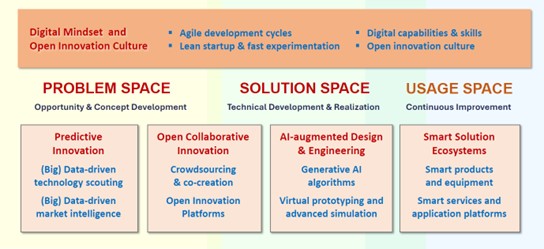Artificial Intelligence – a Revolution for Innovation?
Artificial intelligence (AI) has made groundbreaking progress in recent years, particularly through innovations in machine learning and neural networks. These developments are largely driven by deep learning technologies, which enable the recognition of complex data patterns and the achievement of human-like performance in areas such as speech recognition, image processing, and decision-making.
Language models like GPT, capable of understanding and generating natural language, are revolutionizing communication and automation. Systems like DALL·E, which can create images from text descriptions, are also remarkable. These advances open new possibilities in creative and technical fields that were previously considered difficult to automate.
In healthcare, for example, AI supports disease diagnosis by analyzing vast amounts of medical data to enable more precise and faster diagnoses. In the automotive industry, AI systems are driving the development of autonomous vehicles, which have the potential to significantly improve road safety. In finance, AI algorithms optimize trading strategies, risk assessments, and customer service processes, while in manufacturing, intelligent robots are making production more efficient and flexible.
But there are challenges: Despite the impressive progress, the development of general, human-like AI remains a long-term goal. Ethical questions surrounding AI, particularly regarding bias, transparency, and data protection, are increasingly coming to the fore. These concerns have led to discussions about the need for regulation and ethical standards to ensure the responsible use of AI. The control over AI models, which are becoming more complex and harder to interpret, also remains a significant challenge.
However, AI remains one of the most promising technologies, fundamentally changing both everyday life and industry. The InnovAltion Leadership Summit, held on Sep. 24 at 3M’s Customer Innovation Center in Neuss, Germany, provided some insights into how AI can become in particular a gamechanger in fostering innovation. Christin Schack, vice president and managing director Central Europe at 3M, set the stage for the summit by describing a solution called “Visual Attention Software” that the multi-technology company uses: While 3M is a material science company, the solution predicts the visual attention helping designers optimize, e.g., signages, combining software and material.
An AI Augmented New Framework for Digitally Transforming Innovation
Frank Piller, Head of Chair, Institute for Technology & Innovation at RWTH Aachen University explained how AI can augment the entire innovation process using the “AI-enhanced double diamond model”. AI in this model allows to expand the range of problem as well as solution ideas, facilitates concept generation and expedites go-to-market and commercialization, ultimately resulting in an entirely new framework for the digital transformation of the innovation process (Fig. 1).

Fig. 1: A framework for the digital transformation of the innovation process. │ © Frank Piller
As a proof of this concept he showed how a radically new design of a sailing boat can be accomplished using a Generative Adversarial Network (GAN). GAN is a deep learning architecture. It trains two neural networks competing against each other to generate more authentic new data from a given training dataset. Furthermore, he showed how 3D manipulated microstructure data from bamboo can be used to design stools and how AI can create a book containing a machine-generated summary of all current research about Li-ion-batteries. Finally, he introduced the “self-driving chemical laboratory” which orchestrates artificial intelligence and robotic solutions to accelerate autonomous material discovery.
AI Already Proving Itself as a Gamechanger in Innovation
Hergen Schultze, head of Data Analytics and Senior Research Fellow at BASF provided insights into how BASF is already embedding AI into their innovation process using the workflow-driven and Machine Learning supported multi-criteria optimization tool “Qritos”. This tool captures comprehensive state-of-the-art knowledge, builds a “digital literature twin model” from this information and combines it with Bayesian and Pareto optimization techniques to expedite experimental design. To show feasibility of this approach he presented a paint formulation optimization study based on numerous parameters as input.
How AI can enhance material discovery by significantly widening the space of possible materials was presented by Daniel Zügler, senior researcher at Microsoft. Combining AI emulation techniques which enable estimating material properties very fast compared to 1st principle models (factor 103-106) with GenAI which can tap into an enormous space of entirely new materials not in existing data sets yet, designing new materials with new properties will be taken to another level.
“Zero Prototyping” – in other words getting design right as soon as possible with only a few, ideally zero iterations, is something Siemens is already striving for since the 1980s. Dirk Hartmann, senior principal scientist for Simulation and Digital Twin at Siemens explained how existing resources can be made much more effective in aircraft engine bracket design by using AI techniques, emphasizing the importance of data acquisition for scale and increase of overall business return.
Neil Maiden, professor of Digital Creativity, City St. George’s University of London, inspired the audience by showing how AI can augment human creative thinking introducing a new approach to reframe professional work. Looking for example into asset innovation in general, co-creative AI technologies can help to automatically navigate white box spaces and interactively explore new ideas.
Finally Jens Wagner, business design director of Accenture alluded to the challenge of permanent change being the new normal and relevance being the new growth driver. In order to drive innovation based on customer insights and to solve customer problems much faster, Accenture created an “Innovation Machine” which, starting with a synthetic persona generator, smartly connects all touchpoints to create a human-like conversation. Ultimately unmet customer needs are revealed, which can be screened, clustered and contextualized, hence creating an automatically driven R&D innovation backlog.
The Impact of AI on People’s Work
Key questions revolving around the whole notion of AI are still “Will AI make people’s work obsolete?” and “What tasks are expected to be taken over by AI?”. Henry Sauermann, professor of Strategy and ESMT Chair in Entrepreneurship, ESMT Berlin shed some light on how in particular managers’ jobs can be enhanced by AI. Managers typically deal with challenges like complexity, uncertainty, scale and heterogeneity – here AI-driven algorithms can support, i.e., recruiting crowds for open contribution, allocation of tasks or motivation of employees. By the same token he emphasized the need for responsible use of AI algorithms indicating concerns like privacy of employee data, preserved autonomy & creativity in jobs and biases that may affect individual careers.
Along with efforts to make AI an integral part of people’s daily work a completely new set of skills is required for employees. Alexx Henke, director of innovation management at Miele explained how GenAI at Miele is used for optimization across the entire process flow in R&D. As an example he showed how AI-based coding assistance helps to increase efficiency and boost internal developer’s skills as well as satisfaction.
Last but not least, Maik Lange, AI transformation lead & new technology enthusiast at Bayer introduced the concept of robotics process automation using AI-driven avatars on the sales and customer service side which both have their own business knowledge base as foundation, help to turn customer demands and problems into solutions and innovations and deliver those to customers in an automated closed-loop process (Fig. 2).

Fig. 2: AI-enabled closed loop robotics process automation driving innovation. │ © Bayer/Maik Lange
Conclusion
The presentations as well as several panel discussions made clear that AI can definitely act as a game changer in innovation and create a competitive advantage because each company’s data and knowledge is unique and represents a differentiating factor. However, implementing AI should be considered as a strategic approach and organizations need to integrate AI into their business models and structures, accompanied by change management activities and appropriate governance frameworks to ensure employee adoption and risk mitigation. Professional work will be rethought and reframed by enhancing people’s creative thinking and hybrid intelligence will combine the best of human intelligence and machine intelligence.
Stefan Guertzgen, CHEManager





